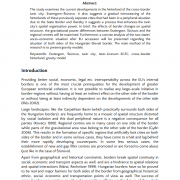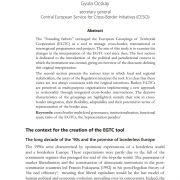(Re)birth of a twin city. Hinterland analysis in the region of Esztergom-Štúrovo
The study examines the current developments in the hinterland of the cross-border twin city, Esztergom–Štúrovo. It also suggests a gradual interweaving of the hinterlands of these previously separate cities that had been in a peripheral situation due to the State Border and thereby it suggests a process that enhances the twin city’s spatial organisation power. In brief, the effects of border changes on spatial structure, the gravitational power differences between Esztergom, Štúrovo and the regional centres will be examined. Furthermore, a concise analysis of the two states’ socio-economic situation after EU accession will be presented regarding the situation of both sides of the Hungarian-Slovak border. The main method of the research is to present gravity models.


